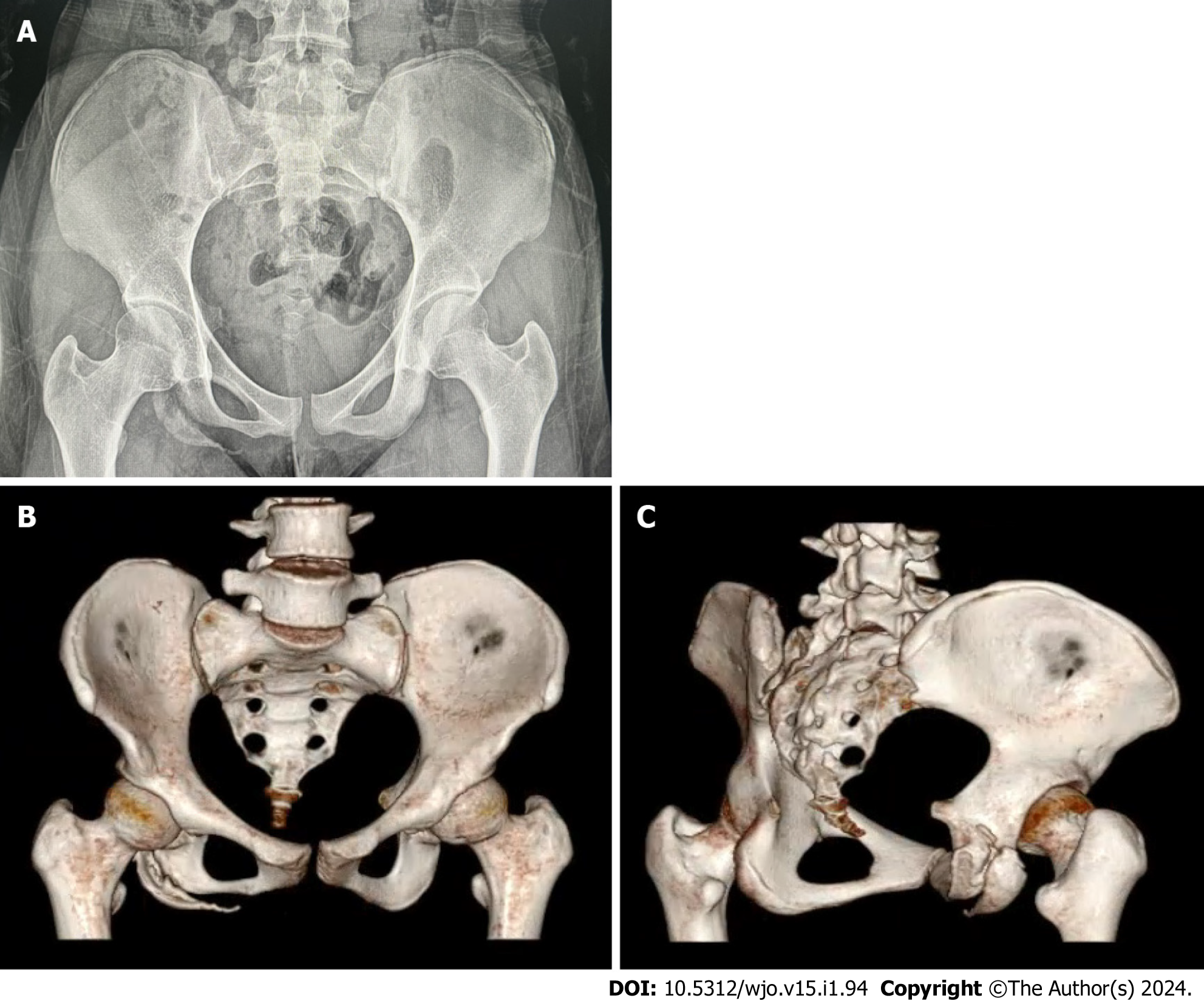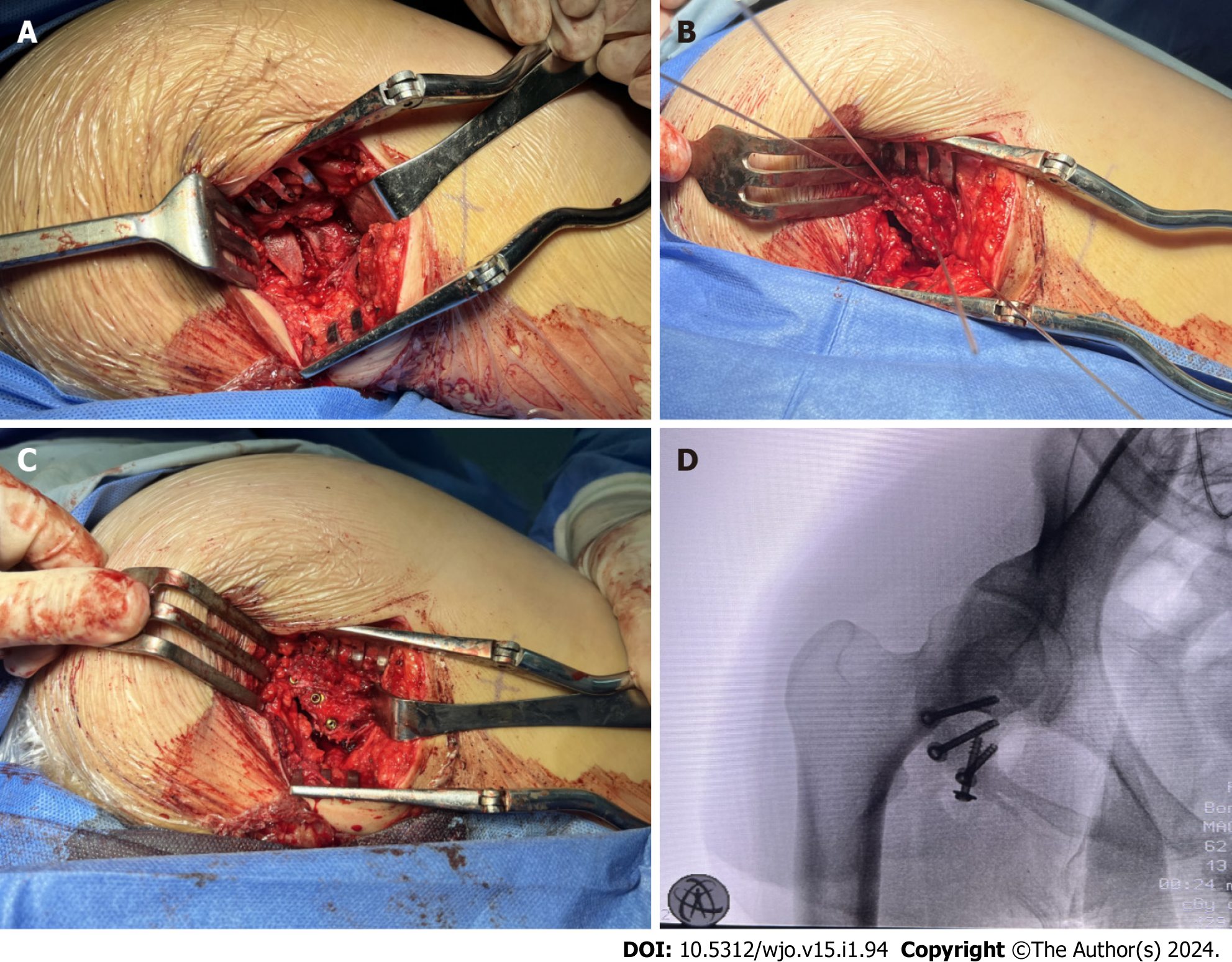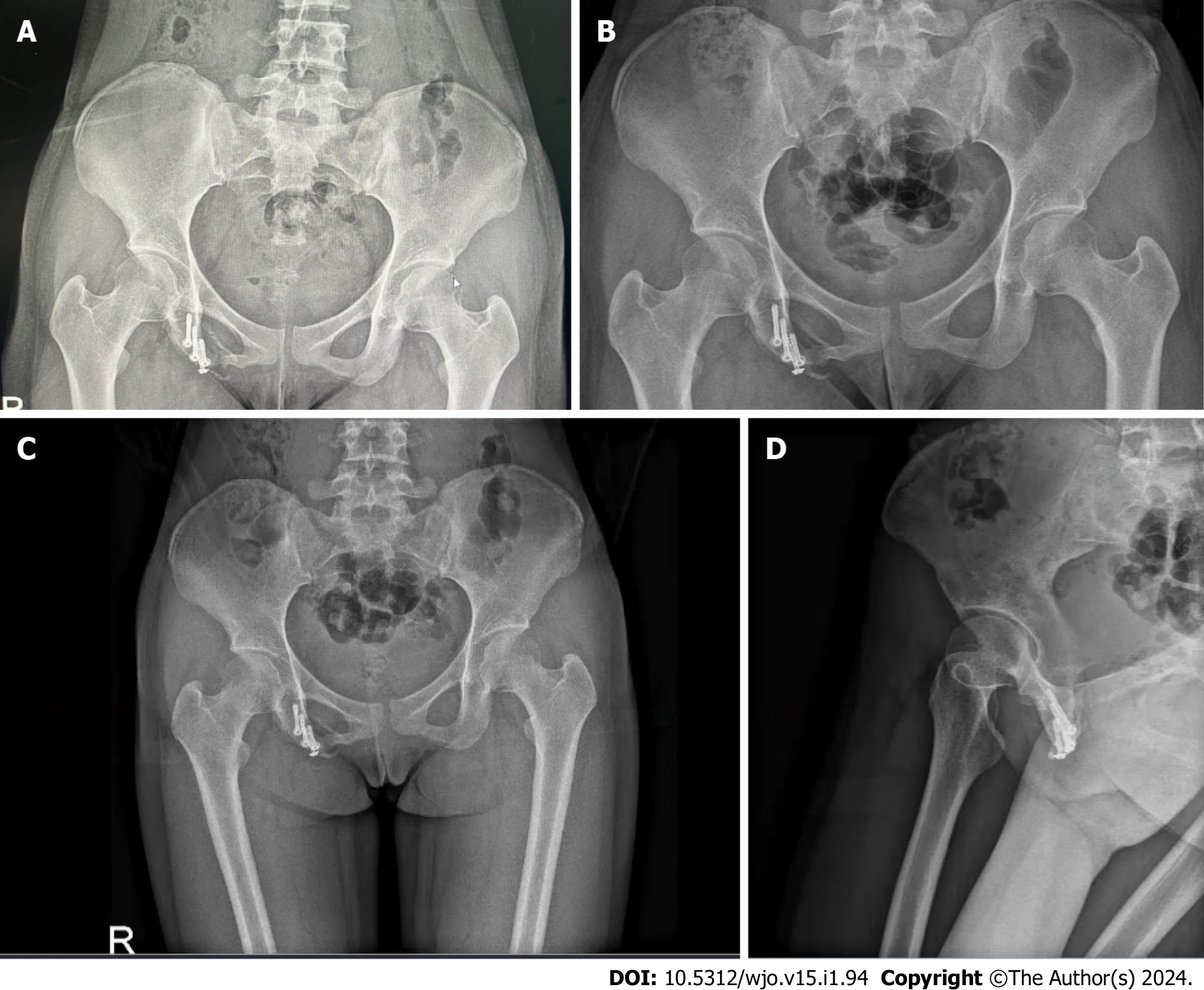Published online Jan 18, 2024. doi: 10.5312/wjo.v15.i1.94
Peer-review started: September 15, 2023
First decision: November 9, 2023
Revised: November 21, 2023
Accepted: December 21, 2023
Article in press: December 21, 2023
Published online: January 18, 2024
Processing time: 122 Days and 14.5 Hours
Avulsion fracture of the ischial tuberosity is a relatively clinically rare type of trauma that is mainly incurred by adolescents during competitive sports activities. According to previous literature, the most commonly involved sports are soccer, sprinting, and gymnastics, in descending order. Dance-induced avulsion fracture of the ischial tuberosity and ischial ramus is extremely clinically rare.
A case of a neglected avulsion fracture of the ischial tuberosity and ischial ramus was diagnosed in a young female dancer who complained of pain and restricted movement of her right hip. She stated that she had suffered the injury while performing a split leap during a dance performance 9 mo prior. Eventually, she underwent surgery and obtained satisfactory treatment results.
Early diagnosis of these fractures is important to ensuring early proper treatment towards a quicker recovery. For old fractures with nonunion and chronic buttock pain, surgery is a preferred therapeutic choice with good treatment outcomes.
Core Tip: Avulsion fracture of ischial tuberosity is a rare type of trauma, mainly incurred by adolescents during competitive sports activities. According to previous literature, the most commonly involved sports are soccer, sprinting, and gymnastics. Dance is rarely involved in these fractures. We here report a case of old avulsion fracture of ischial tuberosity and ischial ramus in a young female dancer. She suffered the injury while split-leaping during a dance performance 9 mo prior. Eventually she underwent surgery and obtained satisfactory treatment results. For fractures with nonunion and chronic buttock pain, surgery is a preferred therapeutic choice with good outcomes.
- Citation: Chen ZR, Liao SJ, Yang FC. Surgical treatment of an old avulsion fracture of the ischial tuberosity and ischial ramus: A case report. World J Orthop 2024; 15(1): 94-100
- URL: https://www.wjgnet.com/2218-5836/full/v15/i1/94.htm
- DOI: https://dx.doi.org/10.5312/wjo.v15.i1.94
Avulsion fractures of the ischial tuberosity are a clinically rare type of trauma and are mainly incurred by adolescents during sports activities[1]. A number of cases, including some cases of old fractures, have been reported in the literature[2-4]; however, few cases have been reported involving dance, and specifically split-leap injury. We here report a case of a neglected avulsion fracture of ischial tuberosity and ischial ramus in a young female dancer. She suffered the injury while split-leaping during a dance performance 9 mo before her presentation. Eventually, she underwent surgery and obtained satisfactory treatment results.
A 17-year-old female dancer presented with pain and restricted movement of her right hip in the outpatient clinic of our hospital.
The patient reported that she sustained the right hip injury 9 mo previously while performing a split leap during a dance show. She felt a “pop” and subsequently experienced severe pain in the right hip, followed by difficulty walking. The patient thought that it was a muscle strain, so she rested at home without medical consultation. A month later, the pain had abated and she was able to walk, albeit with a slight limp. However, she was still unable to fully return to her dance training. The pain continued over 8 mo, especially when she was sitting for a long period of time or attempted to return to her dance training. Therefore, she visited a local hospital and a plain pelvic radiograph was taken, which demonstrated an old fracture of ischial tuberosity and ischial ramus. Thus, she was referred to our hospital for further treatment.
The patient had no medical history of past illness.
The patient had no special personal and family history.
Upon physical examination, there was mild tenderness over the ischial tuberosity and ischial ramus. Pain was induced with flexion, abduction, and external rotation of the hip. The abduction and extension muscle strength of the affected right hip were diminished compared to those of the left hip.
There were no abnormalities in the laboratory examinations.
The plain radiograph of the pelvis (Figure 1A) demonstrated an unhealed fracture of ischial tuberosity and partial ischial ramus. The fragment was displaced anterolaterally by approximately 2 cm. The computed tomography (CT) scan and the 3D reconstruction of the pelvis (Figure 1A and B) showed that the fracture fragment of the ischial tuberosity and partial ischial ramus measured 6.4 cm × 1.3 cm × 2.9 cm in size.
Based on the history and the physical examination and imaging investigation results, the patient was diagnosed with an old ununited avulsion fracture of the ischial tuberosity and partial ischial ramus.
After the patient was informed as to the treatment options for the fracture, she communicated a strong preference for operative treatment for the fracture in her right hip. Soon after, she was admitted to the orthopedic ward and underwent surgery. During the procedure, the patient was posted in a lateral position with the hip and knee flexed at 90°. An 8-cm transverse incision was made along the gluteal crease. With the retraction of the gluteus muscles, the sciatic nerve was identified, and the fracture fragment of ischial tuberosity and ischial ramus was exposed (Figure 2A). Fibrous scar tissue was removed with a curet to freshen the ends of the fracture, and the fragment was restored to its original position. Four φ 1.2-mm Kirschner wires were utilized as guides (Figure 2B), along which four φ 4.0-mm cannulated compression screws with washers were screwed in to fix the fracture (Figure 2C). The tapering ischial ramus was tied using absorbable threads. C-arm fluoroscopy confirmed that the fracture was properly reduced and that the screws were an appropriate length and in appropriate position (Figure 2D). Postoperatively, the right hip was immobilized for 6 wk, and rehabilitation with hip abduction and flexion exercises was started thereafter.
At the 8-wk postoperative follow-up, the patient could stand and walk without any discomfort. She was instructed to start training to develop the full range of motion and muscle strength of the hip. At the 3-mo follow-up, her right hip showed rather good function, and the radiograph revealed that the fracture line was fuzzy; however, heterotopic ossification was seen surrounding the fracture (Figure 3A). At the 6-mo follow-up, hip function was well recovered and the flexion and extension strength of the affected hip was basically the same as that of the left hip, albeit the hip abduction strength was slightly weaker. The patient had taken up physical exercises such as playing badminton and could jump without any pain in her buttocks. The fracture was well healed according to the X-ray film without exacerbation of heterotopic ossification (Figure 3B). At the latest 16-mo follow-up, the patient reported no discomfort in daily activities and no pain while sitting for a long time, even when performing straddling with flexion and abduction of the hip in combination with extension of the knee. The fracture had fully healed according to the X-ray film (Figure 3C and D).
Avulsion fractures of ischial tuberosity almost always occur in adolescents, in whom the vulnerable unfused epiphysis can be easily avulsed with a sudden and forceful eccentric contraction of the hamstrings[5]. Avulsion fractures are usually incurred during competitive sports, such as soccer, sprinting, and gymnastics[6], when the affected leg is forced into hyperflexion of the hip with full extension of the knee[7]. Avulsion fractures sustained in the course of dancing are uncommon, because dancers often have higher flexibility than athletes who play other competitive sports that require greater strength[8,9]. To the best of our knowledge, there have been only three cases reported in the literature[2,9,10]. In the present case, the avulsion fracture of ischial tuberosity along with ischial ramus occurred while the patient was performing a split jump in a dance show. The anterolateral displacement of the fracture fragment implied that the injury resulted from the intense contraction of the hamstring and adduction muscles, and in the context of the abrupt flexion and abduction of the hip in combination with extension of the knee.
Nearly all avulsion fractures can be identified with standard pelvic X-rays[11]. Nevertheless, the aspecificity of reported symptoms and the lack of awareness of these injuries frequently result in them being misdiagnosed as muscular strains or tendinous tears[1,6]. CT and magnetic resonance imaging scans are useful for the differential diagnosis of avulsion fractures with no or minimal displacement from muscular or tendinous tears[12].
Currently, there is no consensus on the treatment of avulsion fractures of ischial tuberosity due to a lack of evidence-based management guidelines[13]. However, the degree of fragment displacement is generally an important factor to consider in the selection of treatment methods[14]. For fractures with no or minor displacement, conservative treatment is often adequate, but strict immobilization of the affected hip for a time period and proper or graded physical rehabilitation are essential[11]. However, strict immobilization of the affected hip is sometimes unacceptable or unattainable for some active patients, and improper movement of the hip may induce displacement of the fragment. Operative treatment is generally suggested for fractures with a displacement > 2 cm[11,15], or even > 1.5 cm in athletes and manual laborers to allow for a faster return to pre-injury activities[16,17]. Old fractures frequently present with symptoms including pain, muscle weakness, and nerve complications, and old fractures with radiological manifestations of nonunion always require surgery[3,4,18]. The presented fracture radiographically exhibited 2.0 cm of displacement and nonunion, and the patient did not achieve the expected level of healing after 9 mo of rest. Given the persistent pain and restricted motion of the hip, the patient opted for operative treatment. The surgery was performed in a lateral position, with the hip and the knee flexed at 90°, enabling passive movements of the joints and clear exposure of the ischial tuberosity during the operation[17]. In addition, a sub-gluteal transverse approach was selected for the surgery in consideration of the location, shape, and size of the fracture fragment. The transverse approach facilitates the exposure and reduction of the fracture and has cosmetical advantages.
The follow-up results with regards to function evaluation in the present case were satisfactory. The latest follow-up showed that the patient had no discomfort while carrying out daily activities and was able to take up moderate-intensity sports. Her hip abduction strength remained slightly weak, and as a result the patient decided to end her pre-injury career as a dancer, which she regretted.
In conclusion, avulsion fractures of the ischial tuberosity are relatively rare injuries and are usually incurred during high-intensity sports. Early diagnosis of these injuries, which can occur during sport activities, even including dancing, is important to ensure early proper treatment for a quicker recovery. For old fractures with nonunion and chronic buttock pain, surgery is the preferred therapeutic choice that can lead to good treatment outcomes.
Provenance and peer review: Unsolicited article; Externally peer reviewed.
Peer-review model: Single blind
Specialty type: Orthopedics
Country/Territory of origin: China
Peer-review report’s scientific quality classification
Grade A (Excellent): 0
Grade B (Very good): 0
Grade C (Good): C
Grade D (Fair): 0
Grade E (Poor): 0
P-Reviewer: Viswanathan VK, United States S-Editor: Wang JJ L-Editor: A P-Editor: Yuan YY
| 1. | Calderazzi F, Nosenzo A, Galavotti C, Menozzi M, Pogliacomi F, Ceccarelli F. Apophyseal avulsion fractures of the pelvis. A review. Acta Biomed. 2018;89:470-476. [RCA] [PubMed] [DOI] [Full Text] [Full Text (PDF)] [Cited by in RCA: 17] [Reference Citation Analysis (1)] |
| 2. | Schoensee SK, Nilsson KJ. A novel approach to treatment for chronic avulsion fracture of the ischial tuberosity in three adolescent athletes: a case series. Int J Sports Phys Ther. 2014;9:974-990. [PubMed] |
| 3. | Ali AM, Lewis A, Sarraf KM. Surgical treatment of an ischial tuberosity avulsion fracture with delayed presentation. J Clin Orthop Trauma. 2020;11:S4-S6. [RCA] [PubMed] [DOI] [Full Text] [Cited by in Crossref: 6] [Cited by in RCA: 6] [Article Influence: 1.2] [Reference Citation Analysis (0)] |
| 4. | Lutz PM, Knörr M, Geyer S, Imhoff AB, Feucht MJ. Delayed proximal hamstring tendon repair after ischial tuberosity apophyseal fracture in a professional volleyball athlete: a case report. BMC Musculoskelet Disord. 2021;22:578. [RCA] [PubMed] [DOI] [Full Text] [Full Text (PDF)] [Cited by in Crossref: 1] [Cited by in RCA: 1] [Article Influence: 0.3] [Reference Citation Analysis (0)] |
| 5. | Gidwani S, Bircher MD. Avulsion injuries of the hamstring origin - a series of 12 patients and management algorithm. Ann R Coll Surg Engl. 2007;89:394-399. [RCA] [PubMed] [DOI] [Full Text] [Cited by in Crossref: 72] [Cited by in RCA: 64] [Article Influence: 3.6] [Reference Citation Analysis (0)] |
| 6. | Vadhera AS, Knapik DM, Gursoy S, Perry AK, Kunze KN, Singh H, Westrick JC, Chahla J. Avulsion fractures of the ischial tuberosity in the pediatric athlete: a systematic review and return to sport analysis. J Pediatr Orthop B. 2022;31:508-516. [RCA] [PubMed] [DOI] [Full Text] [Cited by in Crossref: 3] [Cited by in RCA: 1] [Article Influence: 0.3] [Reference Citation Analysis (0)] |
| 7. | Wood DG, Packham I, Trikha SP, Linklater J. Avulsion of the proximal hamstring origin. J Bone Joint Surg Am. 2008;90:2365-2374. [RCA] [PubMed] [DOI] [Full Text] [Cited by in Crossref: 170] [Cited by in RCA: 149] [Article Influence: 8.8] [Reference Citation Analysis (0)] |
| 8. | Rossi F, Dragoni S. Acute avulsion fractures of the pelvis in adolescent competitive athletes: prevalence, location and sports distribution of 203 cases collected. Skeletal Radiol. 2001;30:127-131. [RCA] [PubMed] [DOI] [Full Text] [Cited by in Crossref: 270] [Cited by in RCA: 176] [Article Influence: 7.3] [Reference Citation Analysis (0)] |
| 9. | Biernacki J, Sugimoto D, D'Hemecourt P, Stracciolini A. Ischial Tuberosity Avulsion Fracture in a Young Female Ballet Dancer. J Dance Med Sci. 2018;22:233-237. [RCA] [PubMed] [DOI] [Full Text] [Cited by in Crossref: 2] [Cited by in RCA: 2] [Article Influence: 0.3] [Reference Citation Analysis (0)] |
| 10. | Theunissen WWES, Jonkers F, Besselaar AT. A boy with acute pain in his right buttock. Ned Tijdschr Geneeskd. 2020;164. [PubMed] |
| 11. | Schuett DJ, Bomar JD, Pennock AT. Pelvic Apophyseal Avulsion Fractures: A Retrospective Review of 228 Cases. J Pediatr Orthop. 2015;35:617-623. [RCA] [PubMed] [DOI] [Full Text] [Cited by in Crossref: 72] [Cited by in RCA: 69] [Article Influence: 6.9] [Reference Citation Analysis (0)] |
| 12. | Meyers AB, Laor T, Zbojniewicz AM, Anton CG. MRI of radiographically occult ischial apophyseal avulsions. Pediatr Radiol. 2012;42:1357-1363. [RCA] [PubMed] [DOI] [Full Text] [Cited by in Crossref: 12] [Cited by in RCA: 10] [Article Influence: 0.8] [Reference Citation Analysis (0)] |
| 13. | Di Maria F, Testa G, Sammartino F, Sorrentino M, Petrantoni V, Pavone V. Treatment of avulsion fractures of the pelvis in adolescent athletes: A scoping literature review. Front Pediatr. 2022;10:947463. [RCA] [PubMed] [DOI] [Full Text] [Full Text (PDF)] [Cited by in Crossref: 9] [Reference Citation Analysis (0)] |
| 14. | Nauta HJA, van der Made AD, Tol JL, Reurink G, Kerkhoffs GM. Satisfactory clinical outcome of operative and non-operative treatment of avulsion fracture of the hamstring origin with treatment selection based on extent of displacement: a systematic review. Knee Surg Sports Traumatol Arthrosc. 2021;29:1813-1821. [RCA] [PubMed] [DOI] [Full Text] [Full Text (PDF)] [Cited by in Crossref: 3] [Cited by in RCA: 3] [Article Influence: 0.8] [Reference Citation Analysis (0)] |
| 15. | Biedert RM. Surgical management of traumatic avulsion of the ischial tuberosity in young athletes. Clin J Sport Med. 2015;25:67-72. [RCA] [PubMed] [DOI] [Full Text] [Cited by in Crossref: 22] [Cited by in RCA: 22] [Article Influence: 2.2] [Reference Citation Analysis (0)] |
| 16. | Eberbach H, Hohloch L, Feucht MJ, Konstantinidis L, Südkamp NP, Zwingmann J. Operative versus conservative treatment of apophyseal avulsion fractures of the pelvis in the adolescents: a systematical review with meta-analysis of clinical outcome and return to sports. BMC Musculoskelet Disord. 2017;18:162. [RCA] [PubMed] [DOI] [Full Text] [Full Text (PDF)] [Cited by in Crossref: 96] [Cited by in RCA: 76] [Article Influence: 9.5] [Reference Citation Analysis (0)] |
| 17. | Ferlic PW, Sadoghi P, Singer G, Kraus T, Eberl R. Treatment for ischial tuberosity avulsion fractures in adolescent athletes. Knee Surg Sports Traumatol Arthrosc. 2014;22:893-897. [RCA] [PubMed] [DOI] [Full Text] [Cited by in Crossref: 44] [Cited by in RCA: 37] [Article Influence: 3.4] [Reference Citation Analysis (0)] |
| 18. | Jorgensen JE, Mølgaard CM, Kristinsson J. Surgical fenestration and rehabilitation of a sports traumatic non-union ischial tuberosity fracture - Case report. Int J Surg Case Rep. 2018;53:362-366. [RCA] [PubMed] [DOI] [Full Text] [Full Text (PDF)] [Cited by in Crossref: 3] [Cited by in RCA: 4] [Article Influence: 0.6] [Reference Citation Analysis (0)] |











